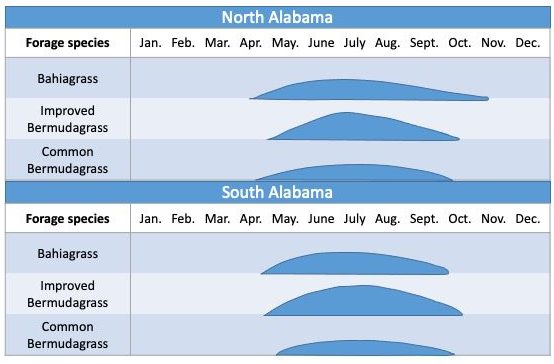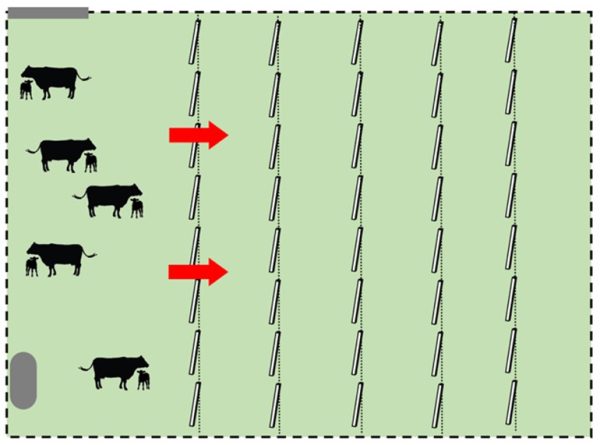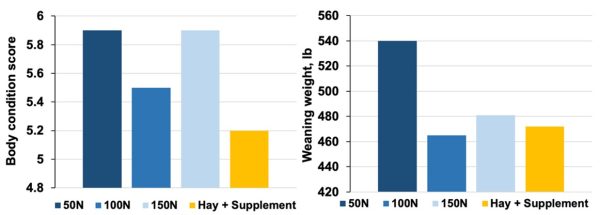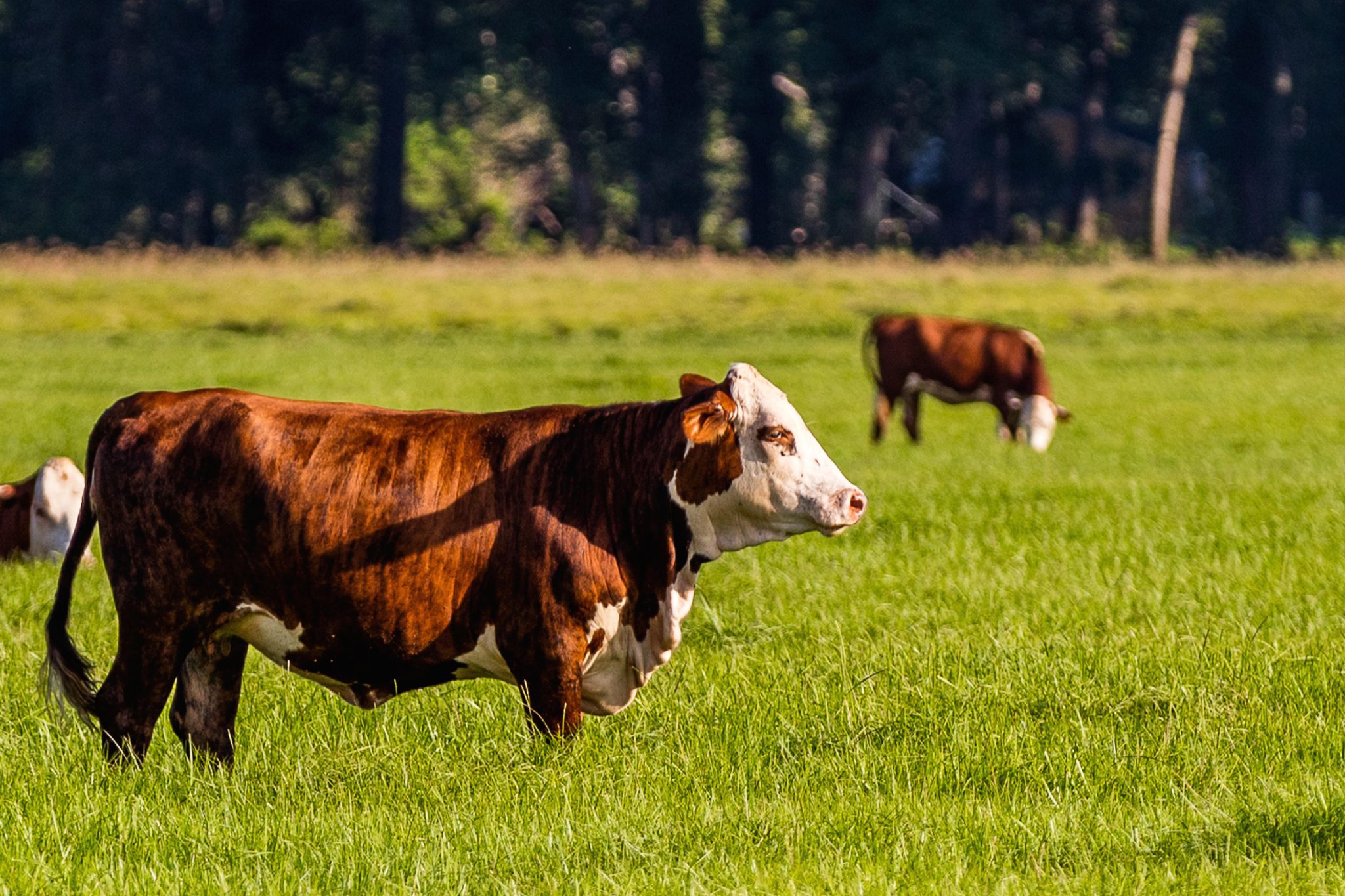Beef

When properly implemented, stockpiling warm-season grasses can provide grazing from late October to mid-January in Alabama.
Most forage production in the southeast is based on warm-season perennial grasses, most commonly bermudagrass and bahiagrass. In states with subtropical climates, such as Alabama, these grasses are highly productive and allow for longer grazing seasons. During the winter months, however, the short days and low temperatures induce dormancy, and stands remain dormant until temperatures warm again in the spring. The lack of forage for grazing during winter often requires supplemental roughage and feedstuffs that increase production costs for livestock producers.
Methods for reducing the reliance on supplemental forage and feed include stockpiling warm-season perennial pastures and overseeding warm-season perennial pastures with cool-season annuals. Stockpiling is the practice of allowing forage to accumulate in a pasture for grazing at a later time when growth is limited. Stockpiling is economically viable when the reduced nutritive value due to plant maturity and weathering is offset by reduced input costs from hay harvest or purchased feed. Warm-season perennial grasses can be stockpiled alone or in a mixture with legumes, such as alfalfa and clovers. When properly implemented, stockpiling warm-season grasses can provide grazing from late October to mid-January in Alabama.
How to Stockpile Warm-Season Perennial Grasses

Figure 1. Seasonal forage of warm-season perennial grasses commonly grown in Alabama.
Stockpiling success is based on several factors, including the forage species, cultivars, and seasonality of production throughout the year. Bahiagrass and bermudagrass are generally productive from early May to early October (figure 1). Both forages are highly responsive to late-fall precipitation; therefore, stockpiling should begin around this fall transition period and will generally start in mid-to-late August or early September.
To begin stockpiling, graze or harvest fields selected for stockpiling to a 3-inch stubble height for bahiagrass and a 4-inch stubble height for bermudagrass. Then remove all animals from the pasture until late October or the first killing frost. Removing mechanically harvested forage from the pasture is recommended to avoid delayed regrowth due to shading from forage residue. After removing existing forage, apply 50 pounds of nitrogen (N) per acre (pounds N/acre) for bahiagrass or 100 pounds for bermudagrass to provide nutrients for adequate regrowth and improve forage quality. If the bahiagrass or bermudagrass pasture is interseeded with an adequate mixture of legumes (at least 30 percent), a lower rate of fertilizer (30 pounds N/acre) can be applied to support early growth, or the nitrogen application may not be required at all. Perform a soil test to determine the nitrogen needed as well as requirements for phosphorus and potassium.
Managing Stockpiled Warm-Season Perennial Grasses Using Grazing

Figure 2. Frontal strip-grazing method.
The grazing of stockpiled pastures must be efficient to reduce forage waste (table 1). Typically, a higher level of grazing management with faster livestock rotation improves efficiency while allowing animals to graze the stockpiled area continuously results in more waste.
Frontal strip-grazing provides the greatest efficiency. This method consists of confining animals to an area of grazing for 2 to 3 days and providing access to the next strip ahead as needed based on forage availability. Frontal strip grazing involves using a temporary or movable electric fence ahead of the animals when permanent cross fencing is unavailable. There is no need to restrict access behind animals since forage will not regrow there until the next management season (Figure 2).
When implementing a frontal strip-grazing pasture, set the first strip to be grazed closest to the water source and the mineral feeder to avoid having the animals trample the forage to get to them. Allow access to a new strip every 2 or 3 days without back fencing so the animals can access the previously grazed area as well as the water and minerals.
Table 1. Expected Efficiency of Grazing Methods
| Grazing Method | Grazing Efficiency |
|---|---|
| Continuous stocking | 30%–40% |
| Slow rotation (in paddock for more than 7 days) | 50%–60% |
| Moderate rotation (in pad- dock for 7 days or fewer) | 60%–70% |
| Strip grazing | 70%–80% |
Benefits of Stockpiling Warm-Season Perennial Grasses
Bermudagrass

Figure 3. Cow body condition scores and calf 205-day weaning weights across the season grazing stockpiled Tifton 85 bermudagrass.
A series of studies on Alabama farms show that stockpiling warm-season perennial grasses can significantly improve forage availability and reduce the need for supplemental feed (table 2). Over a 2-year period, Tifton 85 bermudagrass was stockpiled under three different fertilization rates (50, 100, and 150 lb N/ acre) using the 3- to 4-day frontal strip grazing method. The number of grazing days was 127 per acre. Nitrogen rates exceeding 50 lb N/acre on grazing days or forage production showed no benefit. Fertilizing stockpiled Tifton 85 using 50, 100, and 150 lb N/acre resulted in 11.3, 12.0, and 14.5 percent crude protein (CP), respectively. CP across N rates of stockpiled Tifton 85 (12 percent CP) was greater than Tifton 85 hay (9 percent CP) harvested previously from the same areas during the summer (table 2). Stockpiling Tifton 85 fertilized using 50 pound N/acre resulted in greater cow body condition scores and calf weaning weights across the season than hay and whole cottonseed supplementation (Figure 3). Economically, the study showed that stockpiling bermudagrass can be nearly three times less expensive to support lactating beef cows than feeding the bermudagrass hay and whole cottonseed supplements (table 3).
Another 2-year evaluation of stockpiling Tifton 85 fertilized using 50 lb N/acre for 6 to 8 weeks of accumulation reported a herbage accumulation of 6,722 pounds of dry matter per acre (table 2). The nutritive value of stockpiled Tifton 85 bermudagrass declined as the grazing season progressed. CP reduced from 10 percent early in the season in November to 7 percent later in the season in early January. Similarly, total digestible nutrients (TDN) declined from 61 to 56 percent over this time. In this trial, stockpiling Tifton 85 bermudagrass met energy needs to achieve a target gain of 2 pounds per day for growing beef stockers (average weight approximately 620 pounds) early in the grazing season but did not meet these needs at the end of the season. Thus, growing cattle may need additional energy and protein supplementation later in the season.
Table 2. Average Forage Accumulation and Nutritive Value of Stockpiled Warm-Season Perennial Grasses in Alabama
| Location | Species | N rate (lb/acre) | Forage Accumulation (lb DM/acre) | CP1 (%) | TDN2 (%) | Study Type |
|---|---|---|---|---|---|---|
| Headland | Bermudagrass | 50 | 4635 | 12 | 60 | Grazing, beef cow-calf pairs |
| Headland | Bermudagrass | 50 | 6722 | 8 | 57 | Grazing, stocker cattle |
| Shorter | Bermudagrass+Alfalfa | 0 | 2750 | 18 | 74 | Small plot, clipping |
| Multilocation* | Bahiagrass | 60 | 1394 | 14 | 62 | Small plot, clipping |
Table 3. Comparison of Stockpiled Tifton 85 Bermudagrass and Hay and Cottonseed Supplementation on Cow-Calf Winter Feeding
| Input | Stockpiled T85 | Hay + Supplement |
|---|---|---|
| Labor | $16.97 | $32.50 |
| Hay | $0 | $237.27 |
| 6 lb whole cottonseed/head/day | $0 | $146.16 |
| 50 lb N/acre | $23.91 | $0 |
| Grazing cost | $108.80 | $0 |
| Machinery costs | $24.50 | $90.63 |
| Total expense/cow | $174.18 | $506.53 |
Bermudagrass-Alfalfa Mixtures
In a trial conducted in Shorter, Alabama, with mixed alfalfa-bermudagrass pastures, different stockpiling period lengths (6, 8, 10, 12, and 14 weeks) were evaluated with no N applied. The stockpiling period did not affect forage accumulation, which averaged 2,750 pounds of dry matter per acre across all stockpiling periods (table 2). Considering a pasture utilization of 75 percent, stockpiled bermudagrass-alfalfa mixtures could provide about 92 grazing days per acre during the fall forage deficit. Stockpiling alfalfa-bermudagrass mixtures resulted in excellent CP and TDN, while no nitrogen was required (table 2). The nutritive value of stockpiled alfalfa-bermudagrass mixtures has the potential to reduce supplemental feeding needs during the fall forage shortage.
Bahiagrass
In another study conducted at four different locations across Alabama, stockpiling bahiagrass for 6, 8, and 10 weeks fertilized using 60 lb N/acre resulted in forage production of 1,172, 1,134, and 1,416 pounds of dry matter per acre, respectively, with a mean forage production of 1,394 pounds dry matter per acre across all locations (table 2). Considering a pasture utilization of 75 percent, stockpiling bahiagrass for 6, 8, or 10 weeks could provide approximately 44, 43, or 53 grazing days per acre, respectively. In bahiagrass, CP and TDN decrease from 15 to 12 percent CP and 63 to 59 percent TDN as the stockpiling period increases from 6 to 10 weeks. The CP and TDN across the stockpiling period support the nutritional needs of cows at any stage of production. Still, energy supplementation might be needed if bahiagrass is stockpiled for 10 weeks or longer. When providing stockpiled bahiagrass for stocker cattle, energy supplementation is necessary if the grass is stockpiled for 6 weeks, while supplementing energy and protein is necessary if it is stockpiled for 8 weeks or longer.
Summary
Stockpiling warm-season grasses can provide grazeable forage to help reduce the need for supplemental feed during the fall and winter. Farmers can expect better or similar growing performance with adequate pasture management by providing livestock with stockpiled warm-season perennial grass pastures rather than warm-season perennial grass hays. Keep in mind, however, that supplementation may be required during times of freezing temperatures due to deterioration of the stockpiled material and reduced nutritive value of the available grazable forage. Labor and costs associated with fertilizer, hay harvesting or purchasing, and grazing management must be considered when deciding between hay supplementation or stockpiling warm- season perennial pastures.
Resources
- Ball DM, CS Hoveland, GD Lacefield. 2015. Southern Forages: Modern concepts for forage crop management, 5th edition. International Plant Nutrition Institute. Peachtree Corners, GA.
- Bivens KR, MK Mullenix, JJ Tucker, BE Gamble, RB Muntifering. 2017. Stockpiled Tifton 85 bermudagrass for backgrounding stocker cattle. Journal of Animal Science. 95:4413–4420.
- Holland CM, K Marchant, L Kriese-Anderson, B Gamble, R Muntifering. 2018. Stockpiled “Tifton 85” bermudagrass for cow-calf production as influenced by nitrogen fertilization. Journal of Animal Science. 96:2907–2922.
 Carol Vasco, Postdoctoral Fellow, Animal Sciences & Forages, Maggie Justice, Graduate Student, Animal Sciences, Michael Agar, Graduate Student, Animal Sciences, Kim Mullenix, Extension Specialist, Associate Professor, Animal Sciences, Leanne Dillard, Extension Specialist, Assistant Professor, Animal Sciences & Forages, all with Auburn University.
Carol Vasco, Postdoctoral Fellow, Animal Sciences & Forages, Maggie Justice, Graduate Student, Animal Sciences, Michael Agar, Graduate Student, Animal Sciences, Kim Mullenix, Extension Specialist, Associate Professor, Animal Sciences, Leanne Dillard, Extension Specialist, Assistant Professor, Animal Sciences & Forages, all with Auburn University.
New June 2022, Stockpiling Warm-Season Perennial Grasses, ANR-2897

